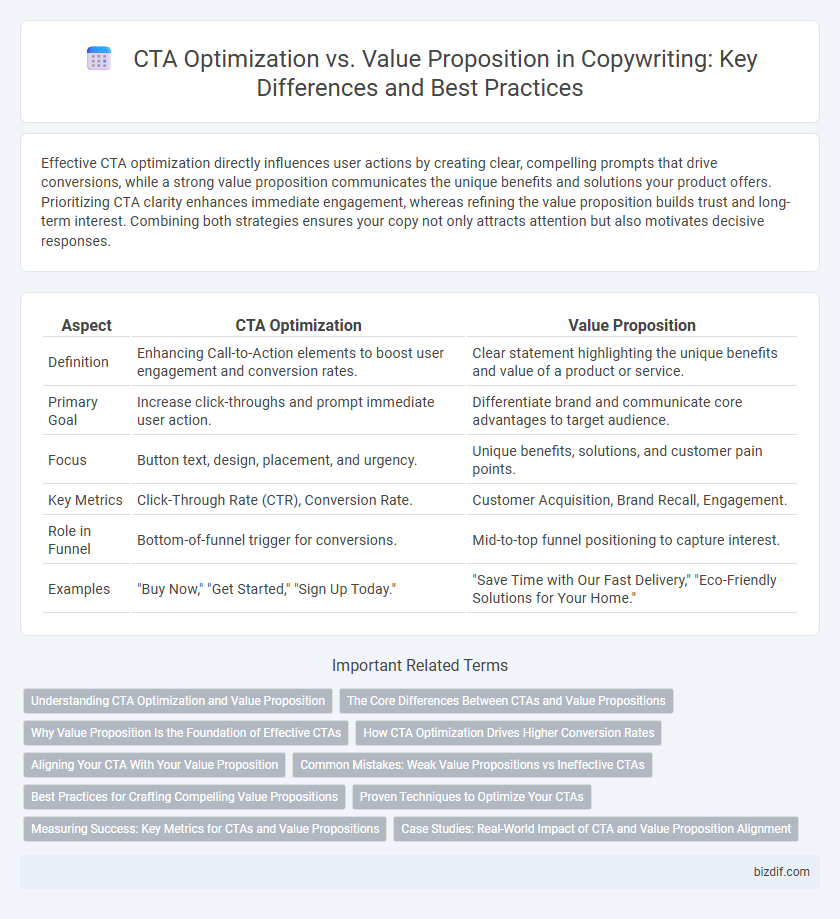Effective CTA optimization directly influences user actions by creating clear, compelling prompts that drive conversions, while a strong value proposition communicates the unique benefits and solutions your product offers. Prioritizing CTA clarity enhances immediate engagement, whereas refining the value proposition builds trust and long-term interest. Combining both strategies ensures your copy not only attracts attention but also motivates decisive responses.
Table of Comparison
| Aspect | CTA Optimization | Value Proposition |
|---|---|---|
| Definition | Enhancing Call-to-Action elements to boost user engagement and conversion rates. | Clear statement highlighting the unique benefits and value of a product or service. |
| Primary Goal | Increase click-throughs and prompt immediate user action. | Differentiate brand and communicate core advantages to target audience. |
| Focus | Button text, design, placement, and urgency. | Unique benefits, solutions, and customer pain points. |
| Key Metrics | Click-Through Rate (CTR), Conversion Rate. | Customer Acquisition, Brand Recall, Engagement. |
| Role in Funnel | Bottom-of-funnel trigger for conversions. | Mid-to-top funnel positioning to capture interest. |
| Examples | "Buy Now," "Get Started," "Sign Up Today." | "Save Time with Our Fast Delivery," "Eco-Friendly Solutions for Your Home." |
Understanding CTA Optimization and Value Proposition
Understanding CTA optimization involves crafting clear, compelling calls-to-action that drive user engagement and increase conversion rates by prompting immediate responses. Value proposition focuses on communicating the unique benefits and core value a product or service delivers, addressing customer needs and differentiating from competitors. Effective copywriting balances both elements by integrating a strong value proposition with optimized CTAs to maximize impact and user motivation.
The Core Differences Between CTAs and Value Propositions
Call-to-Action (CTA) optimization centers on creating clear, persuasive prompts that drive immediate user actions, such as clicking, signing up, or purchasing. Value propositions communicate the unique benefits and core reasons why a product or service stands out, establishing credibility and trust with the audience. While CTAs trigger immediate responses, value propositions build long-term customer engagement by highlighting key differentiators and addressing customer needs.
Why Value Proposition Is the Foundation of Effective CTAs
Value proposition clarity drives higher conversion rates by clearly communicating the unique benefits customers receive, making CTAs more compelling and relevant. A strong value proposition aligns user intent with the CTA, reducing friction and enhancing user trust. Emphasizing value ensures CTAs motivate action by addressing core customer desires and needs, establishing a foundation for effective copywriting.
How CTA Optimization Drives Higher Conversion Rates
CTA optimization drives higher conversion rates by creating clear, action-oriented prompts that guide users toward completing desired goals, such as purchases or sign-ups. Effective CTAs leverage persuasive language and strategic placement to capture attention and reduce friction in the decision-making process. By testing different wording, colors, and sizes, marketers can identify the most compelling CTA variants that directly increase user engagement and conversion rates beyond the influence of value propositions alone.
Aligning Your CTA With Your Value Proposition
Aligning your CTA with your value proposition ensures a consistent message that resonates with your target audience, increasing conversion rates significantly. Clear CTAs reflecting the core benefits of your value proposition create trust and motivate users to take action promptly. Optimizing this alignment enhances user experience by seamlessly guiding prospects through their decision-making process.
Common Mistakes: Weak Value Propositions vs Ineffective CTAs
Weak value propositions often fail to clearly communicate the unique benefits of a product, diminishing overall engagement and conversion rates. Ineffective CTAs typically lack urgency or clarity, causing hesitation and missed opportunities for user action. Prioritizing a strong value proposition alongside a direct, compelling CTA can significantly enhance click-through rates and customer acquisition.
Best Practices for Crafting Compelling Value Propositions
Effective value propositions clearly communicate unique benefits and address customer pain points to attract and retain attention. Incorporating specific, measurable outcomes enhances credibility and differentiates the offer from competitors. Aligning the value proposition with the CTA ensures coherent messaging that drives higher conversion rates.
Proven Techniques to Optimize Your CTAs
Proven techniques to optimize your CTAs include using action-oriented language that aligns with your value proposition, ensuring clarity and urgency to drive conversions effectively. A/B testing different CTA placements, colors, and copy boosts engagement by identifying which variations resonate best with your target audience. Leveraging social proof and emphasizing immediate benefits within CTAs enhances trust and motivates users to take desired actions promptly.
Measuring Success: Key Metrics for CTAs and Value Propositions
Tracking click-through rates (CTR) and conversion rates provides critical insights into CTA effectiveness, highlighting user engagement and immediate actions taken. Measuring metrics like customer retention, lifetime value (CLV), and brand perception reveals how well the value proposition resonates over time, influencing sustained loyalty and brand trust. Combining these metrics allows marketers to refine both CTAs and value propositions, ensuring a cohesive strategy that drives both short-term actions and long-term customer relationships.
Case Studies: Real-World Impact of CTA and Value Proposition Alignment
Case studies reveal that aligning CTA optimization with a strong value proposition significantly boosts conversion rates by clearly communicating benefits and guiding user actions. Brands that integrate targeted CTAs reflecting their core value propositions experience higher engagement and customer trust, resulting in measurable ROI improvements. Data shows this alignment reduces bounce rates and increases click-through rates, proving the critical role of cohesive messaging in persuasive copywriting.
CTA Optimization vs Value Proposition Infographic

 bizdif.com
bizdif.com